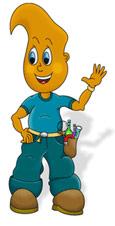
Globule wonders...
How do snowflakes form?
Experiment: Snowflakes
Hypotheses: Ask children what snowflakes are. What are they made of? What do they look like (flower, star...)? Ask them if all snowflakes look the same, and how they form.
Material:
- 2 litre carton of milk, cut in two (or other container of approximately same size)
- See diagram at the end of the manipulation. One container per snowflake.
- String
- Scissors
- Food colouring
- Water
- Kettle
- One spoon per child
- One pipe cleaner per child (preferably white to best see the crystals' colours)
- One stick per child (long enough to be deposited over the container)
- "Borax" laundry detergent (it must be this brand since it has properties specific to this experiment)
Manipulation:
**This experiment uses boiling water. You may want to demonstrate for children instead of allowing them to manipulate the material themselves. Be careful!
- Your daycare worker will give you a pipe cleaner cut into three equal pieces.
- Place your pieces like a star and intertwine the pipe cleaner pieces in the center (see diagram).
- Use string to go around your star, making knots on each "branch".
- Use another piece of string. Tie one end to the star and the other end to the center of your stick. Set aside for now.
- Your daycare worker will pour 2 cups of boiling water in your container. CAREFUL! You must remain calm and be very cautious. Boiling water could harm you or your friends if your container tips over!
- Use a spoon to gently add a spoonful of "Borax". Stir carefully. Continue stirring until you have added 6 spoonfuls of "Borax".
- Once the "Borax" is completely dissolved, add a few drops of food colouring.
- Retrieve the snowflake you made earlier. Deposit the stick on the top of the container so the snowflake is suspended in the solution without touching the sides.
- Let rest until tomorrow morning.
Explanation: How can we explain the formation of the beautiful crystals? When it cools, water does not leave enough room between its molecules for the "Borax" particles. The molecules deposit on the snowflake branches and crystallize.
Similarly, snowflakes form when droplets of water in the clouds cling to miniscule particles floating in the air. Naturally, it must be fairly cold for them to freeze and group together to form snowflakes. Since snowflakes are made of ice, they melt when the thermometer reaches 0⁰C. The snowflake you created is made of salt crystals. You can keep it inside. Why not decorate your daycare with all the snowflakes you made?
Did you know there is an endless possibility of snowflake shapes? Your daycare worker can search the internet to show you pictures of beautiful snowflakes. Snowflakes are tiny masterpieces! If it is snowing outside today, you can catch a few on dark fabric (like your mittens) and observe them.
Angélique Boissonneault
has
a Bachelor's Degree in Biological Science. She has worked in a
laboratory and tested her knowledge. She has taught Math, Chemistry, and
Physics. She has also developed a simplistic and innovative approach
designed to introduce young children to scientific experiments, old and
new. She created her friend Globule. This character is sometimes red,
and sometimes white. He guides little ones through their scientific
experiments and discoveries. It is clear to see Angélique is passionate
about children and science. Globule's Approach.

 Home
Home Theme activities
Theme activities
 Babies and toddlers
Babies and toddlers
 Arts and crafts
Arts and crafts
 Science
Science
 Creative recipes
Creative recipes
 Tips and tricks
Tips and tricks
 Special needs
Special needs
 Extra activities
Extra activities
 Educ-TV
Educ-TV
 Newsletter
Newsletter  Online store
Online store Educatall club
Educatall club

